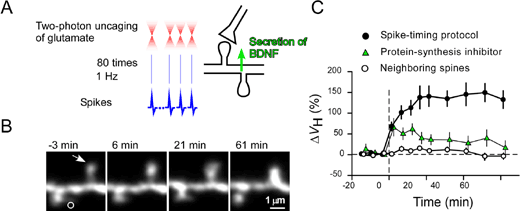Protein synthesis and neurotrophin-dependent structural plasticity of single dendritic spines
Long-term synaptic plasticity in the brain underlies learning and memory and requires protein synthesis for its consolidation. Long-term potentiation (LTP) at glutamatergic synapses is associated with enlargement of dendritic spines. Given that spine structure is the major determinant of spine function, it is important to clarify the dependence of changes in spine structure on protein synthesis. Here we show that repetitive two-photon uncaging of glutamate at single spines without induction of postsynaptic spikes resulted in an immediate enlargement of the spine head that did not require protein synthesis, whereas repetitive pairing of glutamate uncaging plus postsynaptic spikes (spike-timing protocol) gave rise to an immediate but smaller increase in spine-head volume followed by a more prominent enlargement that was entirely dependent on protein synthesis and was accompanied by thickening of the spine neck and spine twitching. The protein synthesis dependent spine enlargement was restricted to the stimulated spine and was also dependent on secretion of brain-derived neurotrophic factor (BDNF) and activation of its receptor TrkB. Indeed, exogenous BDNF induced an additional protein synthesis dependent enlargement of spines already enlarged (or tagged) in response to synaptic stimulation. Thus, dendritic protein synthesis regulates long-term structural plasticity of single spines by tagging and spike-timing controlled action of BDNF.
Program member
Haruo Kasai (Laboratory of Structural Physiology, Center for Disease Biology and Integrative Medicine, Graduate School of Medicine)

Spike-timing stimulation (A) induced spine-head enlargement (B), which was dependent on protein synthesis (C) and selective to stimulated spine.
